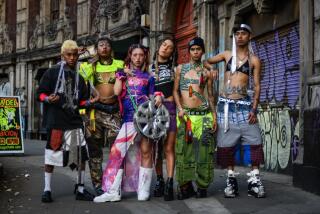The Mexican Dream
- Share via
Picture Jane Russell draped in an Aztec robe, seductively leaning against a pre-Columbian stone pillar with one long leg peeking through her dress. Imagine a World War II propaganda poster with a female St. George slaying a Nazi dragon as an army of long-legged, buxom women waving the Mexican flag cheers her on.
Or contemplate a dark Indian woman as the symbol of Mexico, draped only in a Mexican flag with the national emblem of an eagle devouring a snake in a golden halo behind her.
Those are only a few of the fantasy images created by Mexican poster artists on display at the downtown Latino Museum of History, Art and Culture.
Titled “La Patria Portatil/Portable Homeland,” the exhibition begins in 1898 post-colonial Mexico and moves through the century to contemporary Chicano artists’ interpretations of the images.
The art tells a uniquely Mexican story, blending a romanticized indigenous heritage with the sultriness of Mexico’s stars of the golden age of cinema and Hollywood’s glamorous influence. Painted in lively, glossy colors, these images helped forge Mexico’s national identity in all its contradictions and complexities.
“I was born in Mexico and raised in the United States, and we never had a museum that presented our legacy,” said Denise Lugo, the museum’s director and chief curator. “This brings back those memories of our childhood--the posters you saw hanging in your grandmother’s kitchen. These images were like a cultural blanket that reinforced the good in being Mexican.”
The art may not be the stuff of high-end galleries or auction houses, but as a form of popular art, the posters and paintings have touched thousands of Mexicans and Mexican Americans across generations, said Ana Elena Mallet, curator of Mexico City’s Museo Soumaya, which, along with the Mexican Fine Arts Center Museum in Chicago, organized the show.
“The art is accessible,” said Mallet in a telephone interview from Mexico City. “The elite never took it over, but its painters have a very good technique. This was a way to earn money. From there [the artists] went on to bigger things.” Among the leading calendar artists are Jesus de la Helguera, Jorge Gonzalez Camarena, Jaime Sadurni, Armando Drechsler, Jose Bribiesca, Eduardo Catano and Josep Renau. Gonzalez Camerena was a well-regarded artist, recognized internationally for his sculptures and murals. But others like Helguera died without praise from the artistic community and always considered a mere “almanac painter.”.
*
From its inception, poster art was steeped in mythology, intended originally as a form of propaganda for a country reemerging from a decade of revolution. The revolutionaries who defeated dictator Porfirio Diaz in 1920 wanted to exalt Mexico’s indigenous past. The country’s Indian heritage had been suppressed under 300 years of Spanish colonial rule, followed by the European influence of Austrian Emperor Maximilian when he ruled over Mexico in 1864 and then under Diaz’s 30-year dictatorship, called the Porfiriato.
The new government funded not only the mural paintings of Diego Rivera and David Alfaro Siqueiros, but also promoted chrome paintings and calendars. In 1922, the Objective Teaching school was founded as a way for almanac and calendar painters to teach their art with a patriotic message.
Gone were the European and American Art Deco calendars. In were the Adelitas (women fighters in the revolution), handsome rancheros and their women dressed in rebosos (silk or cotton knitted shawls) and traditional clothing from regions like Oaxaca.
Painters like Helguera borrowed from Aztec mythology, creating epic-sized Aztec warriors protecting voluptuous maidens in an Eden-like garden of cactus flowers, with images of the snowcapped mountains of Ixtacihuatl and Popocatepetl serenely in the background.
Those pictures, however melodramatic, helped create a popular culture that was to be embraced later by Chicano artists. What emerged was a unique blend of contrasts: Indian and Spanish blood merging; a Catholic country that retained pagan worship, a country whose artists glorified the Indian, yet whose poorest citizens were mainly Indians.
Poster art was Mexico’s Hollywoodesque version of reality, said Mallet.
“This was a publicity medium. They wanted to sell the dream of Mexico,” Mallet says. A Mexico whose heroes were enormous, indestructible. The women were tall, voluptuous, but they had very European faces.”
Mexico has always been a melange of identities and nationalities, and the Spanish influence continued to be apparent in the largest calendar factory owned by Spaniard Santiago Galas Arce. Founded in 1913, the printing facility created calendars used by the country’s biggest industries, such as cigarettes, matches, soft drinks, beers, appliances.
Two of the country’s most famous calendar painters, Helguera and Renau, were of Spanish ancestry, but there were other European influences, as well.
German-born Armando Drechsler contributed Art Deco-style calendars in the late 1930s, using stylized models resembling Mary Pickford, Marion Davis and Francesca Bertini wearing Aztec head pieces and colonial dresses.
By the 1940s, Mexico’s golden age of cinema heavily influenced the poster art, with its stars, such as Maria Felix and Dolores del Rio, Emilio “El Indio” Fernandez and Pedro Armendariz serving as models for the painters.
Then during Mexico’s most affluent era--through the 1950s and 1960s--young women wore huipiles (a light knit cotton shirt) in Mexico City’s floating gardens--Xochimilco--selling Orange Crush. Calendars selling tequila, cigarettes and other products were advertised and handed out as gifts to customers during the holiday seasons.
*
The influence of Mexican popular art continues. Each generation has taken those images and reproduced them to their own liking. There is the low-rider who re-creates the scene of a warrior Aztec carrying his sleeping Indian beauty on the hood of his car; there is the prisoner who sketches with an ink pen on his handkerchief in his prison cell reproductions of two Indian lovers embracing; there is a sardonic artist in Chicago who photographs a man in bermuda shorts, T-shirt and Aztec headdress giving directions to a man wearing jeans, shirt and a Spanish conquistador helmet and holding a map, asking, “Which way to Tenochtitlan?”--the Aztec capital.
Mallet said she was shocked to see people crying at the L.A. opening of the exhibition, moved by the melancholy of remembering their homeland.
“Somebody explained to me that in Mexico we don’t have the need to feel Mexican, but these images make people here feel their Mexican-ness,” Mallet said.
It is indeed a portable homeland. However low-brow the form may be considered, poster art will likely endure for many years to come, said Margarita Medina, the Latino Museum’s curator for the show.
“This is what gives life to the exhibit,” Medina said. “Here we are, nearing the end of this century, and our children continue to reproduce these images that were created nearly 100 years ago. Mexicans continue holding strong ties to their culture.”
*
* “La Patria Portatil/Portable Homeland” continues through Aug. 31 at the Latino Museum of History, Art and Culture, 112 S. Main St., Los Angeles. 10 a.m.-4 p.m. Closed Wednesdays. Free.
More to Read
The biggest entertainment stories
Get our big stories about Hollywood, film, television, music, arts, culture and more right in your inbox as soon as they publish.
You may occasionally receive promotional content from the Los Angeles Times.










